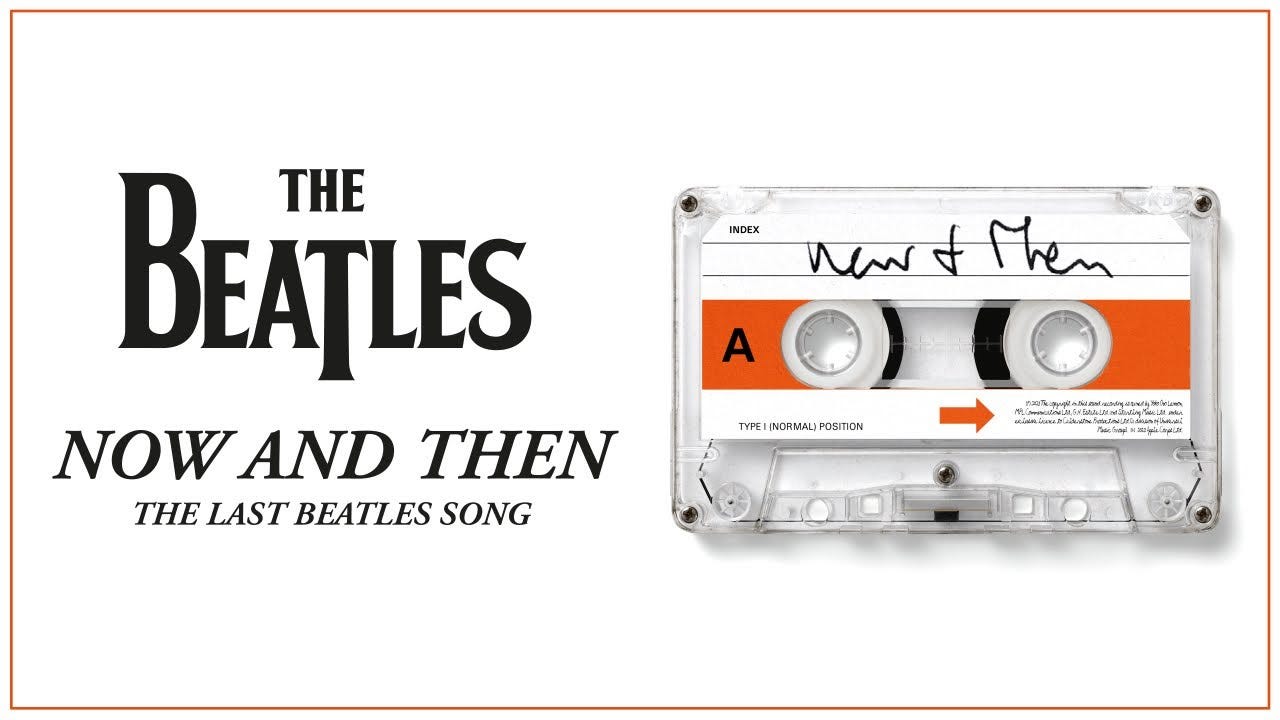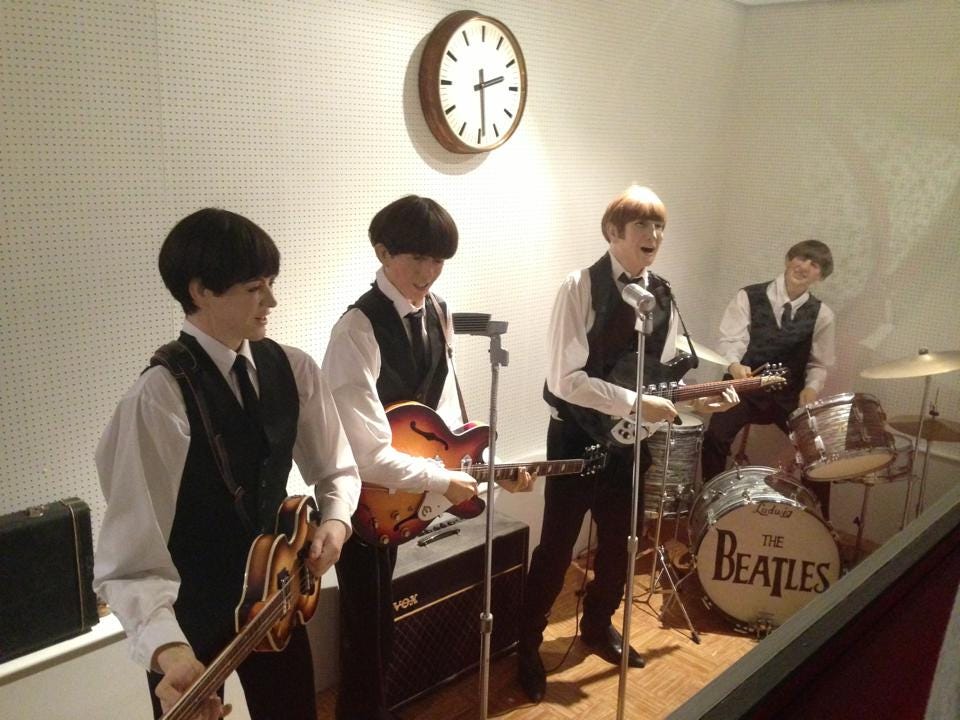“John Lennon at his best despised cheap sentiment and had to learn the hard way that once you've made your mark on history those who can't will be so grateful they'll turn it into a cage for you. Those who choose to falsify their memories — to pine for a Neverland 1960s that never really happened that way in the first place — insult the retroactive Eden they enshrine.” – Lester Bangs in the Los Angeles Times, December 11, 1980 (published three days after Lennon’s murder in New York City)
Depending upon your sentimentality, you may view the new Beatles song as a creepy act of ventriloquism and/or necromancy – John’s corpse dug up and made to sing again – or you may see it as a heartfelt reunion, brokered by tech ingenuity.
The last time The Beatles did this – that is, exhume sub-par Lennon demos and posthumously renovate them – George was still alive. It was the mid-1990s, and the release of “new” Beatles tracks were part of the bloated multi-media project Anthology which comprised an eight-part documentary series, three double-albums of demos, and a lavish coffee table book. To each of the three albums, a new song would be released.
They managed two. The first, “Free as a Bird”, is deathly boring and featured the thin, spectral vocals of Lennon – and not in a good way. Both sketchy and incomplete, McCartney wrote two bridges for the track, sung in turn by him and George, while Harrison added some slide guitar. Its producer – George’s mate from the Travelling Wilburys, Jeff Lynne – would say: “It was so hard. Layering that voice in there, which had piano glued to it. Really difficult, virtually impossible. But we got it done somehow.”
The Beatles’ old producer, George Martin, had turned the project down. He thought it faintly ghoulish. And his technical opinion when the single was released? “What you ended up with was quite a thick homogeneous sound that hardly stops. There’s not much dynamic in it.” He wasn’t wrong.
The second track, “Real Love”, was slight, mawkish, captive to the same awkward lethargy of “Free as a Bird.” The public seemed to agree. Despite an enormous PR machine, and despite the band’s fabled legacy – which right then, in the mid-‘90s, was being burnished once more by the explicit adorations of Britpop’s stars – nobody much cared. The songs themselves just weren’t very good, and the awkwardness of the living bandmates having to bridge themselves to the song’s dead writer with technology made for a depressingly hollow energy.
It was a reminder that The Beatles aren’t just four names on the back of a record: they were a freakish dynamism expressed in a particular time and place. A sum that was vastly greater than its parts. And Jeff Lynne, 25 years after their break-up, laboriously removing tape-hiss from John’s late ‘70s scraps, was no substitute for it.
But McCartney was bullish about the songs. It was exciting, he said, an act of sweet communion with John. But Harrison never seemed convinced, and when time came to work on the third John demo – “Now and Then” – he dismissed it as rubbish and walked away. He was dead a few years later.
Now, decades after the Anthology series, “Now and Then” has finally been released. The crude demo, recorded scratchily by John in the late ‘70s on dictaphone, was once impossible to parse – to separate the vocals from piano. But now, thanks to canny machine learning, the studios of director Peter Jackson – who exhumed and painstakingly cleaned the many hours of mouldering tapes of The Beatles’ Let It Be sessions for 2021’s Get Back series – have isolated those vocals, cleaned them, and allowed the two surviving members to record fresh instrumentation (alongside Harrison’s acoustic rhythm guitar that he recorded in ’95 before he walked away).
Arranging a dead man’s song isn’t the only séance here, either: those still living must make educated guesses about the wishes of the dead too. When George once said the “Now and Then” tape was rubbish, did he mean the quality of the recording – or the song itself? To this, Harrison’s widow, Olivia, has an answer:
Back in 1995, after several days in the studio working on the track, George felt the technical issues with the demo were insurmountable and concluded that it was not possible to finish the track to a high enough standard. If he were here today, [son] Dhani and I know he would have wholeheartedly joined Paul and Ringo in completing the recording of ‘Now and Then’.”
*
“Now and Then” is a tender, piano-led ballad in a minor key, whose instrumentations swell as the song goes on – including some syrupy strings, recorded by session players who were told they were playing on a new McCartney solo record as to thwart leaks. Great secrecy preceded the great marketing campaign, but perhaps the best description of the song I’ve read comes from a mate, who texted me on the morning of its release: “It sounds like a rejected James Bond theme”.
And you know what? It really does. The vocals still sound strange to me, and required subtle buttressing from McCartney who’s low in the mix, but are infinitely better and purer than those on “Free as a Bird”. I’m not crazy about the song but, as Ben Lindbergh writes here, it’s impressively coherent given the restraints: two dead members, and a commitment to maintaining what they’d already recorded. I mean, fuck: elements of this song were made in three separate decades.
There is communion here with John, obviously, but also with the late George – Paul records a slide-guitar solo that sounds very much like something Harrison would’ve recorded in the ‘70s.
The Beatles’ magic still inspires intense devotion. The sentimental devotee will be stirred by the song’s nostalgia – both the key to its lyrics, but also to Paul’s devotion to playing again with his dead friend. “It’s not some sort of cynical marketing exercise to try and push catalogue sales,” the song’s producer, Giles Martin, son of George Martin, told Variety. “I think [Paul] just misses John and he wants to work on a song with him. It’s just as simple as that.”
It might be that simple, but also more intense. The guitarist Carl Perkins, who had once played with McCartney, told an interviewer decades ago that Paul had left the room in tears after hearing Perkins play a song. Its lyrics had reminded him of John’s last words to him: “Think about me every now and then, old friend”.
Beatles fanatics will defend the song musically, while also bathing in the project’s melancholic nostalgia. This is, after all, a séance conducted publicly between Paul and John. And that’s fine – I won’t begrudge it. Enjoy.
But I thought of Phillip Larkin’s small essay on the Beatles in 1983 – three years after Lennon’s murder – when he wrote: “When you get to the top, there is nowhere to go but down, but the Beatles could not get down. There they remain, unreachable, frozen, fabulous.”
Larkin’s point was that their precocious talent had taken them to the top, but once there they’d been hagiographically fixed in place as secular saints. For some, this is still true. But for me, the pregnant cash-cow of the Anthology series brought them back down some way from the misty summit. It was a reminder of the obvious: that they were mortal. That they experienced petty resentments, diminishing ability and errors of judgement. That these once electric boys, who became musically transformative heroes, were now boring and slightly grasping. “Now and Then” is another reminder. It’s a sweet and poignant thing – it’s also very ordinary.
That’s fine. I have their old albums, and the enduring, life-altering passion for music which began after I discovered theirs as a boy. But let’s not pretend this is The Beatles. They died a long time ago.



